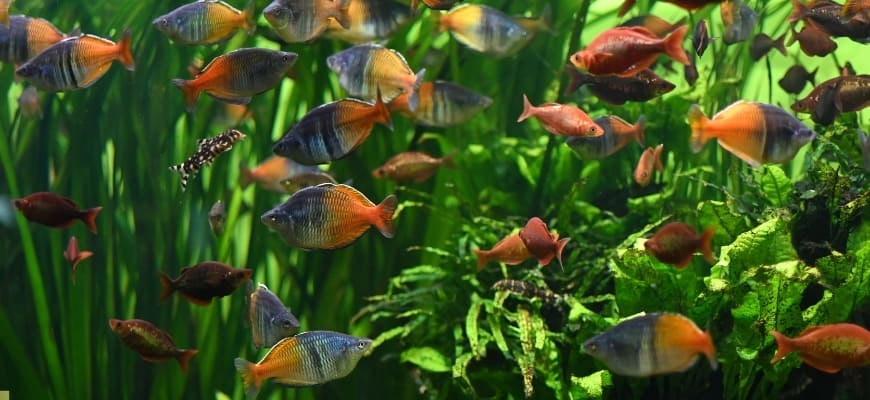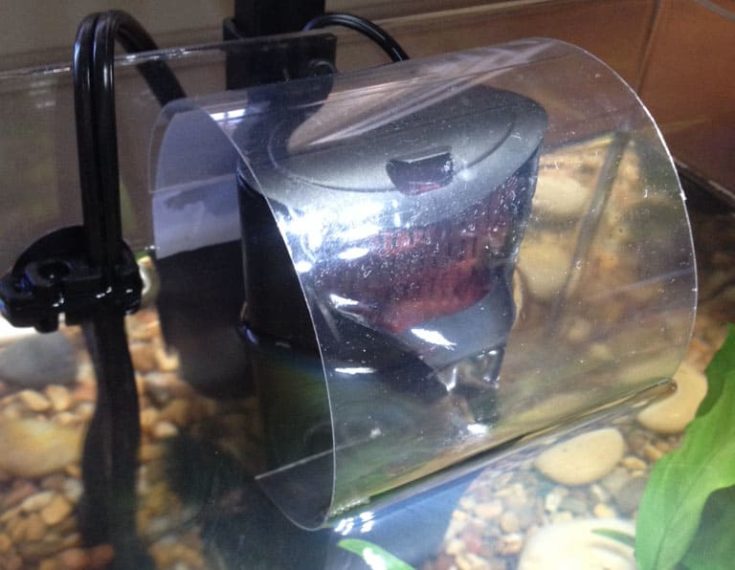Betta fish Popeye is a frightening condition that can give you a nasty shock when you first notice it. However, this condition is simple to diagnose and reassuringly easy to treat and cure with the correct care.
So, why has your betta suddenly developed Popeye? What causes the disease? And how can you cure your beloved betta buddy?
Keep reading to learn everything you need to know about diagnosing, treating, preventing, and curing Popeye in betta fish.
What Is Popeye?
Popeye affects all species of fish, not just bettas. Even people and other animals can suffer from Popeye!
The medical name for Popeye is exophthalmia. The condition occurs when pressure builds up behind the fish’s eye, causing it to become swollen and protrude from the fish’s head. Popeye is unpleasant for your fish and distressing for you to witness. It’s also easier to prevent this condition than it is to treat it.
Popeye can affect one or both of the betta’s eyes.
Is Popeye Fatal To Betta Fish?
Generally, unless Popeye is caused by a secondary bacterial disease that’s either very serious or left untreated, bettas don’t usually die of the condition.
Sometimes, if the condition is caused by trauma to the eye, the actual eyeball might rot away completely, leaving your betta with only one eye. However, although that can make feeding awkward for your pet, it’s unlikely that he will die.
Is Popeye Contagious?
If you keep other fish with your betta, the good news for you is that Popeye isn’t contagious.
However, if the condition is caused by a bacterial infection or some other disease, it’s likely that your other fish might get sick, too. First of all, remove your betta from the tank and put him in quarantine for treatment. Then, carry out a partial water change, maintain the filter system correctly, and don’t introduce any new livestock or plants to the tank for a few weeks until the danger has passed.
What Are The Symptoms Of Popeye In Betta Fishes?
Popeye is pretty easy to recognize in betta fish as it presents with several characteristic symptoms, including:
Bulging Eyes
The classic and most obvious symptom of Popeye is that the betta’s eyes bulge out from its head because of the pressure behind the eyeball.
Cloudy Eye
Often the affected eye or eyes will change color or turn cloudy or milky. In that case, the cornea has most likely been seriously damaged.
Sometimes, the eyes are bloodshot, usually as the result of trauma, such as fighting with tank mates.
White-Ringed Eyes
If you notice that your betta has developed a white ring around his eye, it’s highly likely that he will go on to develop Popeye. Once this symptom has appeared, you need to start treating your pet immediately.
Other Signs Of Popeye
There are a few more general symptoms to watch out for that could indicate that your betta is sickening for some kind of disease, including:
- Not eating
- Inactivity
- Not interacting with other tank mates
- Hanging around the same place for long periods
- Sitting on the substrate
If your betta shows those signs, check the temperature and water parameters in his aquarium. It could be that something is out of whack. If that’s the case, performing a water change or adjusting the temperature could be all you need to do to cure your betta.
What Causes Popeye In Bettas?
Popeye has several different causes, and it can be tricky to isolate the one reason for your betta’s illness. Without a definitive diagnosis of the cause of the condition, choosing the right treatment can be difficult.
First of all, Popeye can affect one or both of your pet’s eyes.
Unilateral Popeye
When the condition affects only one of your fish’s eyes, it’s referred to as unilateral Popeye.
Usually, unilateral Popeye is caused by some kind of injury or trauma that results in a physical injury to the eye. For example, your betta might swim into a sharp decoration in the aquarium or have a fight with a tank mate.
Bilateral Popeye
Bilateral Popeye affects both the fish’s eyes. In that case, the condition is generally caused by some sort of infection.
Infections in the eye can be caused by bacteria, fungus, or parasite activity. Generally, infection is accompanied by a range of other symptoms that affect the whole betta, such as those listed earlier in this guide.
How Do You Prevent Popeye In Betta Fishes?
Prevention is always much better than cure, and there are a few steps that you can take to protect your fishy friend from Popeye.
Preventing Infection
You can prevent infection by keeping your betta fish’s tank clean and well-maintained.
Betta fish are quite sensitive to water quality and temperature. If the water is dirty or contains high levels of ammonia, your betta will get stressed. Stress leads to a weakened immune system, leaving your fish susceptible to attack by parasites and diseases and paving the way for an infection to develop.
Too Many Fish
If you overstock your tank, your filtration system will be overloaded. That can cause polluted water, which will stress your fish.
Also, if you have too many fish, those that are territorial, such as your betta, can become aggressive, and squabbles can break out, sometimes resulting in injuries.

Perform Weekly Water Changes
Again, to maintain good water quality in your fish tank, you need to perform weekly water changes. Take care to vacuum the aquarium gravel thoroughly to remove organic waste matter that would otherwise rot and pollute the water.
Generally, if you have a small betta tank, you’ll need to carry out more frequent water changes than if you keep your pet in a large aquarium.
Maintain Your Filtration System
To ensure good water flow around the aquarium and through the filtration system, you need to rinse the media through in tank water every month or so to remove sludge.
If you neglect that task, the organic filter media will receive a poor flow. That will leave the beneficial bacteria that live in the media starved of oxygen and unable to process the organic waste products in the water.
Filter media typically lasts for around three months, depending on the brand. After that time, you’ll need to replace the media to keep it functioning efficiently.
Quarantine New Fish
If you buy any new fish, inverts, or plants for your main tank, always quarantine them for a couple of weeks. The same applies to any sick fish that you notice in your betta’s tank.
Once you’re sure that all the livestock is healthy, go ahead and introduce it to your main tank.
Remove Aggressive Tank Mates
Bettas are usually peaceful creatures, provided that you keep them with non-aggressive tank mates of other species. However, some bettas are aggressive and will attempt to bully and attack other fish.
If there are trouble-makers in your betta tank, you’ll need to remove them so that your betta doesn’t get injured. You might be able to pass your unwanted fish onto a friend or to your local fish store. If push comes to shove, it might be necessary to keep your feisty betta fish in a small tank by himself.
Remove Dangerous Tank Decorations
Some tank decorations can be potentially dangerous to your betta fish, especially the likes of plastic plants that can have sharp leaves. A spiky leaf could very easily pierce your betta’s eye, leading to Popeye or causing a bacterial infection.
Use A Net
If you need to remove your betta from his aquarium, always use a proper fish net.
Bettas are delicate creatures that can be easily injured if not handled correctly. So, take extra time to lift and move your fish very gently and carefully so as not to accidentally harm him.
Don’t Frighten Your Betta
Did you know that switching on the aquarium lights or turning on a loud TV right next to the tank can terrify your betta fish?
Bettas are sensitive souls that don’t appreciate surprises. So, make sure that the room is light before you turn on the tank lights, and don’t site your tank next to any noisy devices. If your betta is suddenly startled, he might dash around his tank, colliding with decorations and potentially injuring himself.
Buffer The Pump Outflow
In the wild environment, betta fish live in bodies of water where there’s little or no current. You will have a filter system in your betta’s tank to keep the water clean and safe for your fish. But sometimes, the mechanical element of the filter system generates a flow that’s too powerful for your betta.

You see, those gorgeous flowing fins are something of a handicap for your betta fish, especially if he gets caught in the current. That buffeting effect can cause your pet to crash into tank decorations, potentially injuring your betta. So, you should attach a buffer attachment to the filter’s outflow pipe or diffuse the flow by using plants or decorations.
What Are The Best Ways To Treat Popeye in Bettas?
If your treatment of Popeye in your betta fish is to be successful, you need to choose the correct method and remedy.
Here’s how to cure Popeye in betta fish:
Physical Trauma – Epsom Salt
Generally, if your betta’s Popeye has been caused by an injury or some kind of physical trauma, treatment is easier and more likely to be successful than if the condition is bacteria-related.
Usually, a salt bath is a very effective treatment for Popeye that’s caused by trauma.
Salt Bath Treatment Method
- Fill a small container with some tank water.
- Add Epsom salt to the container of water, following the dosage instructions on the packaging.
- Stir the water until the Epsom salt has dissolved, and then carefully place your betta fish into the container.
- Leave your betta in the Epsom salt bath for around ten minutes.
- While your betta is in his bath, float the container in the aquarium to keep the water temperature in the bath the same as it is in your pet’s tank.
If you don’t want to stress your betta by removing him from his tank, you could add aquarium salt to his tank instead. The International Betta Congress actually recommends salt to boost the betta’s immune system, promote a quick recovery from traumatic injuries, and act as a general tonic.
Bacterial Disease
If a bacterial disease is the cause of your pet’s condition, the treatment is somewhat different.
Melafix Treatment Method
- Set up a quarantine tank and put your betta into that.
- Once your betta is settled in the quarantine aquarium, change 50% of the water in your main tank to get rid of whatever is causing the bacterial or parasitic disease and protect your other livestock.
- Treat the betta fish with aquarium salt and over-the-counter medication, such as Melafix.
- Carry out a 100% water change in the quarantine tank every three days, re-treating the tank with fresh aquarium salt and Melafix.
- After ten days, stop treating the water. Your betta fish should be showing signs of making a good recovery by then.
In Conclusion
Did you enjoy our guide to diagnosing and treating Popeye in betta fish? Please share this article if you found it helpful.
Popeye is a nasty condition that can attack bettas. Usually, the disease is caused by physical trauma or bacterial infection. You can prevent both of those causes by keeping your betta’s tank clean and ensuring that all your tank decorations are safe for your fish. Fortunately, Popeye is rarely fatal, especially if you can spot the problem and treat it early.